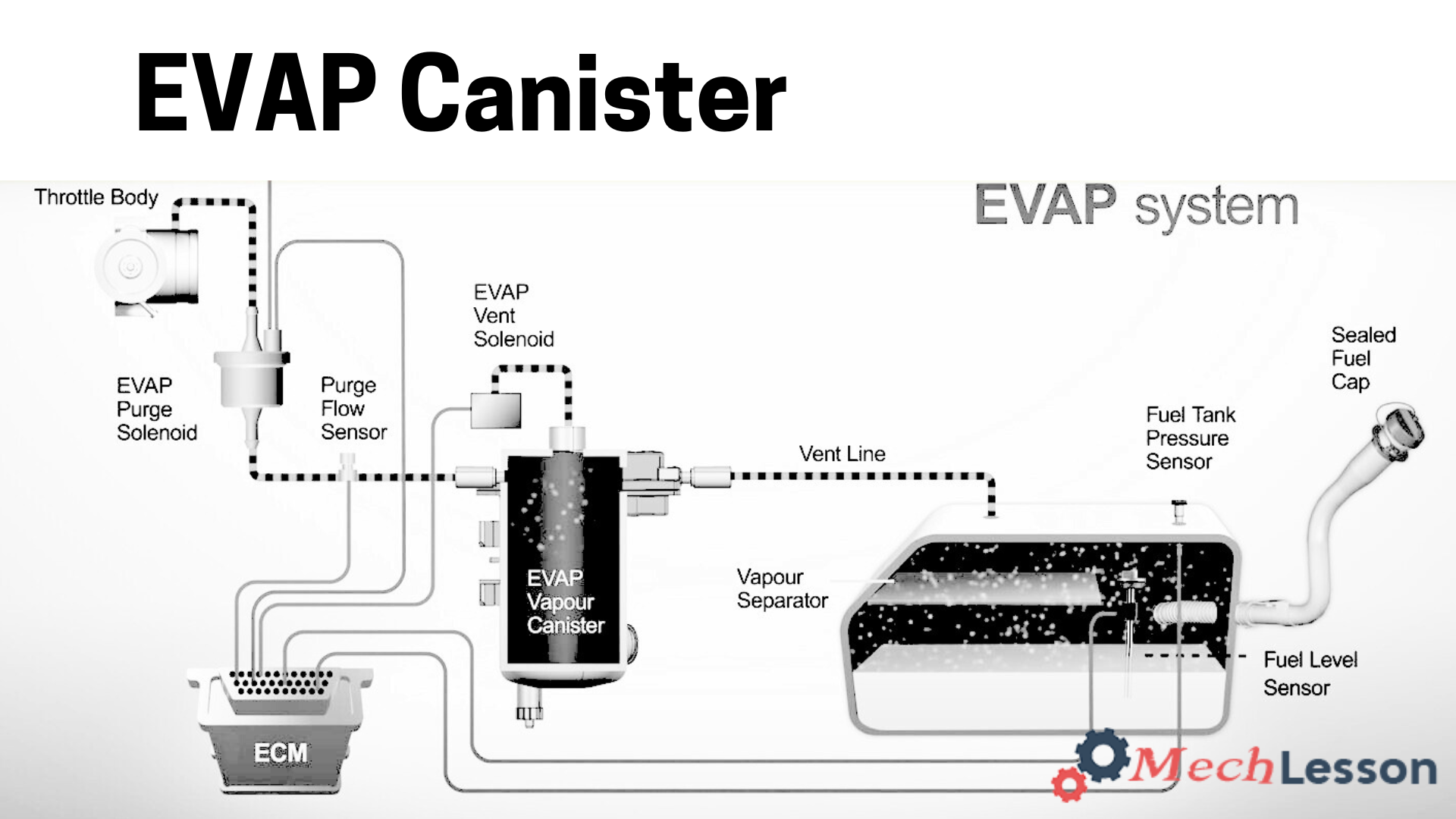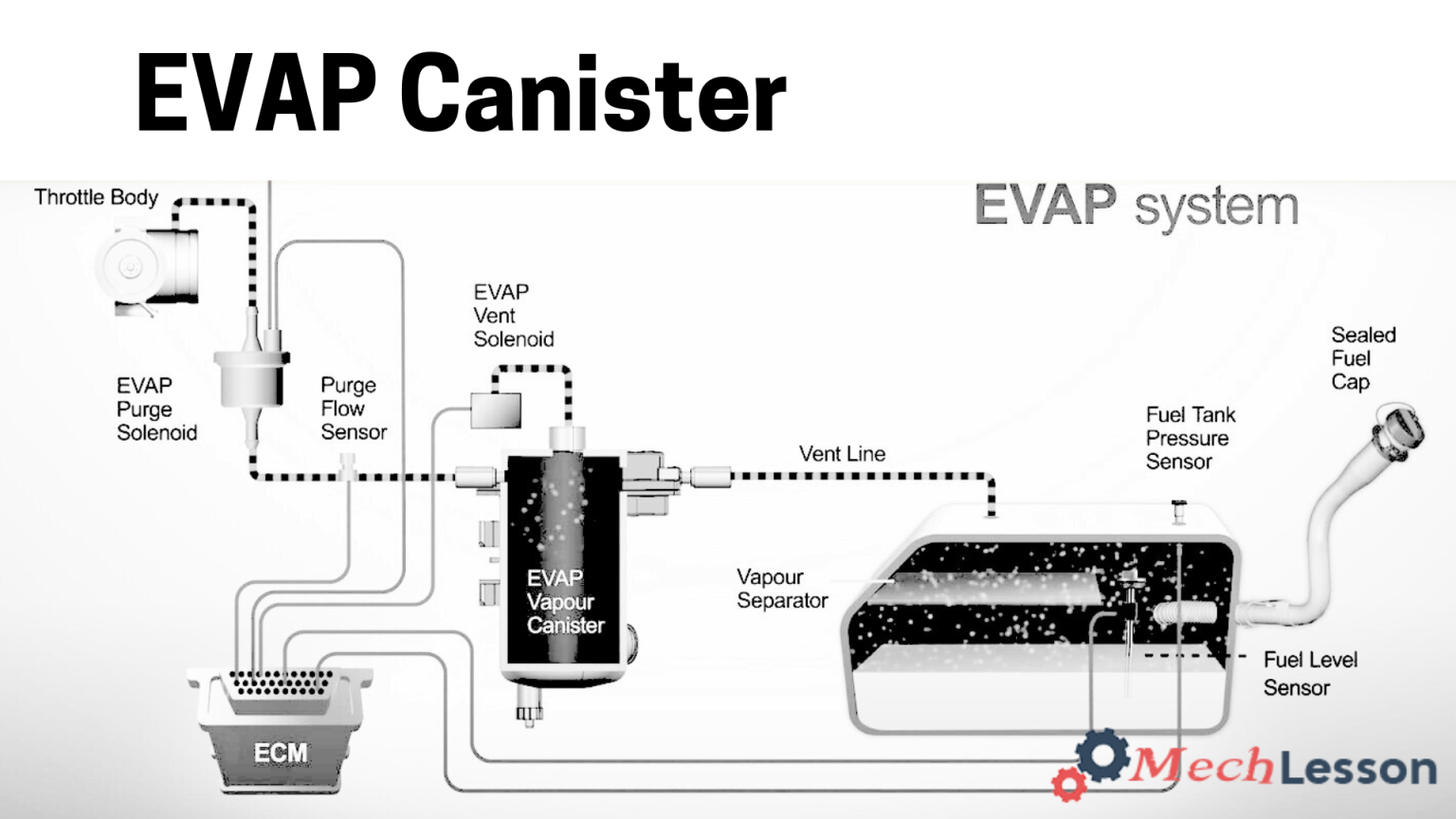The charcoal canister, also known as the EVAP canister, is a crucial component of the EVAP, or Evaporative Emission Control System. This technology helps prevent the release of hazardous fumes from your petrol tank into the environment by utilizing them to fuel the engine.
Car fuel systems use evaporative emission control systems (EVAP) to stop gasoline fumes from escaping into the atmosphere. The EVAP system checks for potential fuel vapor leaks using diagnostics, and if any are found, it gives a fault code.
Additionally, it will turn on the dashboard’s check engine light. Well, in this reading, we’ll explore what an EVAP canister is, its function, diagram, types, and how it works. We’ll also learn the signs of failure.
Let’s get started!
Learn about Spark Plug with this detailed guide!
What Is an EVAP Canister?
The EVAP canister, which is typically a plastic container filled with activated charcoal and attached to the fuel tank via a vent line, absorbs and confines gasoline vapors until the engine starts.
As the vehicle travels, the canister purge valve opens, allowing the intake vacuum to pull the vehicle into the engine for combustion. This charcoal-filled canister, which is a component of the vehicle’s emissions controls, has the function of absorbing fuel vapor that would otherwise vent to the atmosphere and cause pollution.
The purge valve allows trapped vapors to be discharged back into the engine, where they are then burned. Problems with the charcoal canister can frequently cause the check engine light to illuminate and are challenging for mechanics to identify.
All emissions from a vehicle have been subject to legal regulations since the introduction of lambda control on vehicles equipped with a catalytic converter. This includes evaporating fuels (hydrocarbons) from the fuel tank.
These so-called volatile hydrocarbons must be caught and kept for reuse because they are not permitted to enter the atmosphere. Retention and recirculation systems for gasoline vapors are utilized here to comply with regulatory standards. The activated charcoal canister is an integral part of this system.
You should learn How much Does it Cost to Replace a Car Strut with this detailed guide!
Where is it Located?
The charcoal canister or vapour canister is normally found under the car, near the fuel tank. It is frequently covered beneath plastic covers, making it difficult to find. It is sometimes seen in the engine compartment, particularly in European vehicles.
However, depending on the make and model of your car, the location of your charcoal canister can vary substantially. It’s worth noting that I’ve discovered these canisters in the wheel arches of various European brands. If you can’t find it, your local dealership should be able to point you in the right direction.
Diagram Of An EVAP Canister

You should also learn about Valve Cover Gasket with this detailed guide!
Symptoms of a Bad EVAP canister
The following are the most common symptoms of a failing charcoal canister:
The Check Engine Light is on
The computer in your car will frequently detect a problem with the charcoal canister before you do. Because this is a somewhat self-contained car component, it isn’t usually the first item mechanics look for when diagnosing a check engine light.
Keep the additional indications of a faulty charcoal canister in mind so you may correctly determine the source of your engine problems.
Emissions Increase (or Emissions Test Failure)
If you’ve observed a substantial increase in your car’s emissions, your charcoal canister could be to blame. The major function of the EVAP system is to keep excess gasoline vapor from entering the environment.
You may notice that your car’s engine is running richer or that your exhaust has a stronger fuel odor. A malfunctioning charcoal canister can cause your car to fail its mandatory state emissions inspection due to the check engine light and excessive emissions.
You should learn about Camshaft Position Sensor with this detailed guide!
Vehicle Performance Decrease
Because the EVAP system connects directly to the engine via the purge valve, problems with your charcoal canister can influence the performance of your vehicle. If this system fails, the purge valve may become stuck open, impacting the air-fuel mixture in your engine.
As a result, the performance of your car may suffer. If your charcoal canister is faulty, you may notice fewer miles per gallon, difficulty starting your car, or a rough idle.
Problems Filling the Gas Tank
One of the first signs of a clogged fuel vapor vent line or a saturated charcoal canister is problems at the gas pump. You may be unable to fill your tank, or the gas pump nozzle may shut off before your tank is completely filled.
If your canister is incapable of removing vapor from the gas tank, the fumes take up volume, limiting the amount of space you can fill.
Fuel Odor in or Around Your Vehicle
A failing charcoal canister will fail to gather fuel vapors before they escape your motor, resulting in a strong fuel odor in your vehicle. These toxic vapors can sometimes gather within the cabin, posing difficulty for most drivers.
After extended exposure, these fumes can cause headaches, confusion, and even loss of consciousness.
You should also learn about automatic transmission systems with this detailed guide!
Can one drive with a bad or failing charcoal canister?
It is usually safe to drive with a bad or failing charcoal canister. The most common concern for most owners when their EVAP system fails is that their car will emit additional fumes into the environment. If you’re concerned about your carbon footprint as a driver, this may urge you to repair your charcoal canister as soon as possible.
Even if you disagree with the climate change discussion, replacing the canister should be on your to-do list. However, if your bad charcoal canister is causing a strong fuel odor inside your vehicle, you should make this repair as soon as possible.
As previously stated, exposure to fuel vapors can be exceedingly hazardous. If you must drive, open a few windows to allow in some fresh air.
What are the things to check when troubleshooting the EVAP canister?
When troubleshooting this component, here are things you should consider doing:
- Examine the activated charcoal canister for any signs of damage.
- Take a thorough look at the timed valve for any damage.
- Inspect the hoses, lines, and connectors for damage and proper seating/mounting.
- Examine the electrical connections of the timed valve for damage and proper installation.
- Check the grounding and power supplies. To do so, unplug the timed valve’s connector. When the engine is at working temperature, a voltage of around 11 – 14 V must be present (the engine must be heated for lambda control to be active; otherwise, the timed valve cannot be actuated).
- Check with an oscilloscope: Connect the oscilloscope’s measurement line to the ground wire of the timed valve.
- Set the measuring range to X-axis = 0.2 seconds, Y-axis = 15 V.
You should learn about The Right Amount of Brake Fluid You Need For Your Car with this detailed guide!
How much does a charcoal canister replacement cost?
An EVAP canister replacement can cost between $150 and $630. A new part typically costs between $100 and $500, depending on the make and model of your vehicle. You should expect to pay an additional $50 to $130 in labor if you hire a mechanic to replace it.
Charcoal canisters are usually easy to find. However, working on the EVAP system might be complicated, so consult your owner’s manual for further information on how to perform this repair.
Conclusion
The EVAP canister is a crucial component of your vehicle’s emission control system. It captures fuel vapors from the fuel tank and temporarily stores them before they’re sent to the engine to be burned, preventing harmful emissions from entering the atmosphere.
A faulty EVAP canister can lead to poor fuel economy, a check engine light, and failed emissions tests. Timely diagnosis and maintenance are essential for optimal engine performance and environmental safety.
FAQs
What does the charcoal canister do?
The charcoal canister is part of the car’s emissions control system. It captures and stores fuel vapors that evaporate from the fuel tank and fuel system, preventing them from being released into the atmosphere and reducing harmful emissions.
What happens when the charcoal canister goes bad?
When the charcoal canister goes bad, it can lead to increased emissions and trigger the check engine light. It may disrupt the vehicle’s emissions control system and cause environmental pollution.
Does the charcoal canister affect fuel economy?
The charcoal canister’s primary role is to control emissions and does not have a significant direct impact on fuel economy.
You should learn about Carnister Purge Valve with this detailed guide!
What is another name for the charcoal canister?
Another name for the charcoal canister is the evaporative emissions canister.
Why would a car need a charcoal canister replaced?
A car may need a charcoal canister replaced if it becomes clogged, damaged, or develops faults in its components like the purge valve, which can affect emission control.
Can an EVAP canister cause a misfire?
No, the EVAP canister is not directly related to the engine’s combustion process, and it should not cause a misfire. Misfires are typically caused by ignition, fuel, or engine management issues.
What are the symptoms of a bad canister?
Symptoms of a bad canister may include the illumination of the check engine light, increased emissions, and a noticeable fuel odor.
What are the symptoms of a bad canister close valve?
Symptoms of a bad canister close valve may include difficulty starting the engine, rough idling, and decreased fuel efficiency. This valve is responsible for sealing the system to prevent vapours from escaping.
Can a charcoal canister cause stalling?
A charcoal canister is unlikely to cause stalling. If the car is stalling, other issues related to the engine, fuel system, or ignition components should be investigated.
How often should a charcoal canister be replaced?
In general, there is no set interval for replacing charcoal canisters. They are intended to be long-lasting and durable. If you have any difficulties with the canister, get it inspected by a trained mechanic and replaced as needed.

